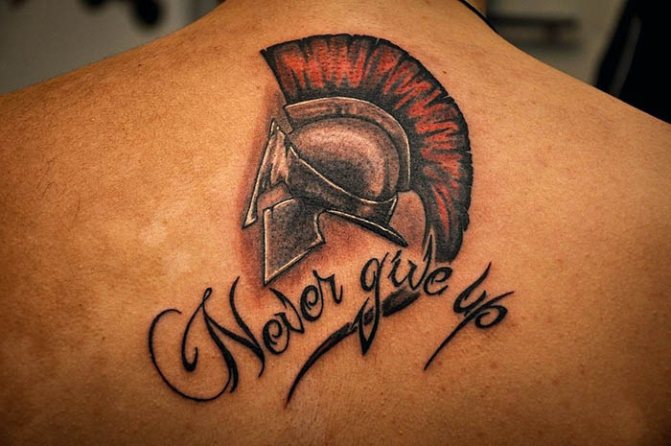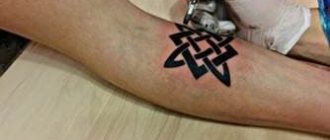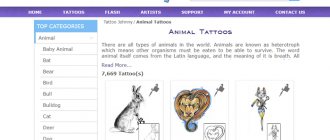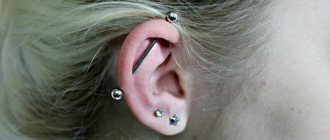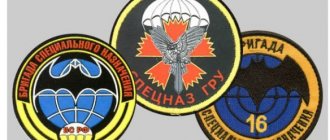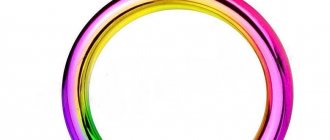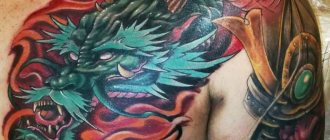Many of us are fascinated by the way people lived in ancient Greece. We love their myths and legends, the heroes and wars in which they participated. We have all heard the stories of the powerful and invincible Hercules, the long and heroic Trojan War, the courageous and clever hero Theseus and the legendary 300 Spartans. Such admiration for this culture has been greatly aided by the modern film industry, which makes gorgeous movies based on stories from the Ancient World. It is thanks to such cinematic works that most of us can have a vivid idea of exactly what the warriors of those times looked like. But, unfortunately, not everyone knows why the soldiers of Ancient Greece dressed like that, what this or that equipment was designed for, why the ancient Greek military headgear was called "Spartan helmets". Just about this will be discussed in this article.
Ancient Sparta
Sparta was a belligerent state which existed on the territory of modern Greece in the period up to 146 B.C. and was located in the southern part of this country. The basis of the state system was the principle of absolute equality and unity. The main support and economic power of Sparta was its army, which in ancient times was the most combat-ready in the world.
All men were experienced warriors and served from adolescence to old age. The men of Sparta were not employed in farming, for it was considered a menial task, and slaves did it instead. It is worth noting that the latter were especially mistreated in this country: they had no rights whatsoever. Interesting is the fact that the slaves of Sparta were only Greeks from the conquered territories, and each of them belonged to the whole Spartan society.
The meaning of tattoos for girls
The masculine meaning of the Spartan tattoo often attracts girls as well. For them, the image of a warrior in armor is primarily a symbol of order, strict adherence to rules, obedience to generally accepted morality. Willingness to take any adversity and loss with dignity, not to succumb to despondency and grief - the meaning of the tattoo put future mothers and wives. In Sparta, women had to escort their husbands and sons to war with the words: "On or with a shield," and in modern life, wives are required to show no less support and faith than before the battle, so that their men come home victorious every day.
Tattoo Spartan can indicate the strength of character of the owner, because the girls who lived in ancient Sparta, often competed on a par with the boys, proving an indestructible desire to gain the victory. Modern female owners of tattoos depicting athletically built warrior stubbornly pursue the goal, sometimes overcoming many obstacles. Willpower of these girls may be the envy of men, but in a relationship and personal life is not all smooth - often stubborn temper interferes with finding a compromise, to give.
An untrue fact
There is a misconception that Spartan warriors did not have protective clothing. It spread thanks to the Hollywood movie 300 Spartans. In fact, it is not true: every warrior was very well equipped not only with weapons, but also with a rather impressive protective outfit.
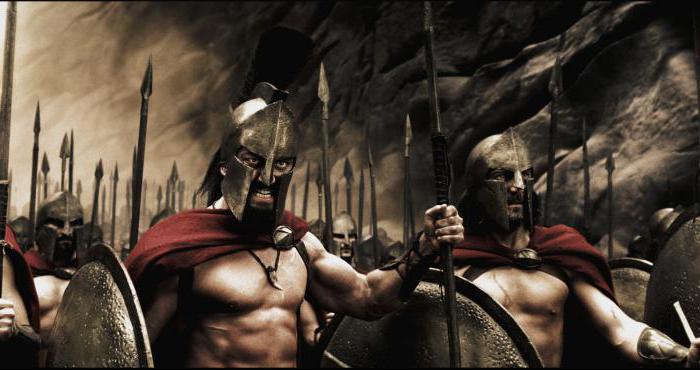
The core of the Spartan army was made up of heavily armed infantrymen, the hoplites. Their armament consisted of a spear, a short sword, and a round Spartan shield, which is well recognized all over the world thanks to the Latin letter "lambda" on it. In addition, soldiers wore armor, greaves, and distinctive Spartan helmets. The description of this equipment will be of interest to many people, and we will talk about it a little later. In addition to the hoplites, the Spartan army also included auxiliary cavalry - the so-called horsemen, which had no practical value, as well as archers.
The meaning of the tattoo for men
The main meaning of the tattoo Spartan - man-protector, guarding the peace of children, giving confidence in the future to his wife, mother, sisters. The role of a strong wall, safeguarding relatives from any attacks from the outside, to the liking of the owner of the tattoo. Next to him, those who are weaker feel safe, and those who are less tall become more confident. Men who choose to tattoo the image of a Spartan in combat gear radiate calm and determination, as they are convinced of their superiority. It is no coincidence that every Spartan warrior was considered a superhuman, able to cope with any difficult task.
Physical power is wonderfully emphasized by the tattoo. Especially good looks the image of a muscular warrior on the strong pumped muscles of the arms, thighs, back. Tattoo gives courage to the whole image and suggests that the owner is able to reach greater heights, because the heavy physical loads do not scare him. Often the picture of a Spartan choose for body decoration athletes with a true warrior spirit, not accustomed to retreat or flee from the battlefield. Such guys do not betray friends and insult opponents, preferring a fair fight rather than bullying from behind.
Spartan helmets: Characteristic differences between the different types
The Spartans were among the first in history to create heavy armor for their warriors, because the main component of their army, the hoplites, needed it vitally. The second place in importance (after shields, of course) was taken with confidence by the Spartan helmets. It is hard to overestimate the importance of this armor element for warriors, because it protects such a vulnerable place as the head. A true Spartan helmet could not be made by hand: even in those distant times there were special technologies for this purpose.
All over Greece, including Sparta, the Corinthian helmet was widespread.
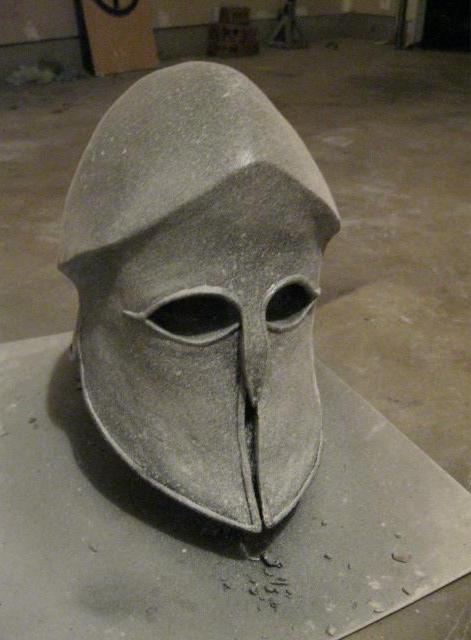

It perfectly coped with its main task - to protect the head from the spear during equestrian fights, but this Spartan helmet, whose photo can be seen in the article, had its drawbacks. It partly limited the sight than narrowed the review of warriors and, covering the ears, significantly reduced their hearing. By the end of the sixth century BC. The Chalcidian type of helmet appeared, which lacked a nose-guard and had special holes in the area of the ears. It is worth noting that the strength of this type was inferior to the Corinthian helmets, because due to the fact that they were not solid, the products were quite easy to bend.
Detailed description and unique features of the Boa® system
- EFFECTIVE FITTING || The Boa® system guarantees a secure fit around the head without pressure points. All day comfort and custom fit is combined with lightness, compactness and precise adjustability. The Boa® system needs no counterweights, minimizing fatigue and eliminating neck strain.
- Thanks to its simple design the Boa® Fit System can be removed from the head as quickly as possible.
- Long Lifetime Warranty || The discs and laces of the Boa® Fit System are guaranteed to remain in good working order throughout the life of the product in which they are incorporated.
- The Boa® Fit System is used by more than 10 million people around the world, in all kinds of industries and environments. No matter what mission you're on, you'll be equipped with the best gear to help you perform effectively, stay confident and stay focused.
The helmet includes:
- bag;
- side mounts for your equipment.
Application of paint on patented technology from Crye Precision, full compliance with the original camouflage is guaranteed, the coating is durable, resistant to abrasion, has zero remission in the infrared spectrum (does not glare in night vision devices).
The Spartan 5.45 DESIGN ballistic helmet provides protection from splinters as well as from 9×18 mm rounds with Pst bullet, ind. 57-H-181C and the 9mm round of the Stechkin automatic pistol APS, id. 56-A-126 (for protection class BR 1). This protection is sufficient because the energy of automatic bullets is much greater and to protect the head from this type of threat would require a significant increase in helmet weight.
Pictured:
9x19(PU), 9x21, armor piercing cartridge 9x19 (pierced like any other helmet) 7.62x55 (TT) non-piercing, bloat on back side
Helmet includes:
- Ballistic hemisphere, which provides protection for the head from pistol bullets and shrapnel;
- the point of attachment of night devices and additional equipment (flashlights, visor);
- side attachment points for attachments (handheld flashlights, video cameras, shooting and ballistic goggles, active headphones and headsets, identification signs, headphone adapters, oxygen masks, applied ballistic shields, applied chin guards, ballistic reinforcement increasing protection class in the frontal part of the helmet;
- Velcro back piece with special shape for placement of affiliation and friendly unit identification signs, infrared markers, fixation of cords and night vision device batteries;
- the inside is a patented underbody device with double fixation (the first part fixes the helmet around the head with a special Boa® clamping device, which is resistant to stretching forces to the sides, the second part holds the helmet by fixing straps in the chin area), the straps of the system are adjusted by special locks to achieve the most comfortable clamping;
- the inside of the helmet is lined with patented cushions made of Zorbium material providing the necessary ventilation during wear and creating several points of contact between the cushions and the head to ensure a comfortable fit.
Additional features of the helmet:
- compatible with night vision devices, equipped with special places for attaching the batteries and directly to the NVS or thermal imager;
- Compatible with oxygen masks for continuous parachute jumps;
- there are mountings for shockproof cameras, individual flashlights, ballistic goggles, active headphones and headsets;
- specially equipped with places for fixing infrared markers, identification means;
- can be used together with visor, side ballistic protective shields, ballistic chin shield.
The construction of the helmet provides resistance to the action of damaging factors during exposure to atmospheric precipitations in the form of rain and snow, during short-term exposure to open fire, as well as during exposure to direct sunlight. The "Spartanets" helmet retains its operational characteristics when the ambient temperature changes from minus 30 deg. C to plus 40 deg. The product has a wide range of adjustment to the human head, including different head sizes, non-standard shapes of the head (elongated, flattened shape) Helmet does not restrict the freedom of movement of the person. The helmet must be worn continuously for at least 8 hours at 18...20 degrees Celsius and up to 90% humidity. It is possible to use the helmet for 3 or more days. The recommended period of wearing the helmet on the head is no longer than 5 days.
Helmet "Spartan" Accessories and materials
Two-piece attachment point for night vision equipment and attachments (Schraud) is a mounting bracket consisting of two parts: the outer part glass-filled polymer (armamide), the inner part heat-treated aluminum D 16T, fastened together by M3 screws, both parts are mounted on the helmet with special screws, in the technological holes in the matrix (directly in the helmet).
The side rails (rails or side arches) are arc-shaped elements attached to the sides of the helmet with bolts, made of high-strength plastic or glass-filled polymer (armamide). The bolts are placed in four special holes: symmetrically two of them in the temporal area, two in the occipital area and hold simultaneously the rails and straps of the underbelly.
Pilos - Spartan helmets
As combat techniques progressed and evolved, the uniforms of warriors naturally changed. When the Laconian tactics of combat began to gain popularity, warriors needed to hear the trumpet whose horn signaled the beginning of the battle. Sharp eyesight and good hearing were unusually important. That is why helmets changed. The Corinthian helmet was replaced by the Pilos helmet. The prototype was a hat that was made of felt material and had a conical shape.
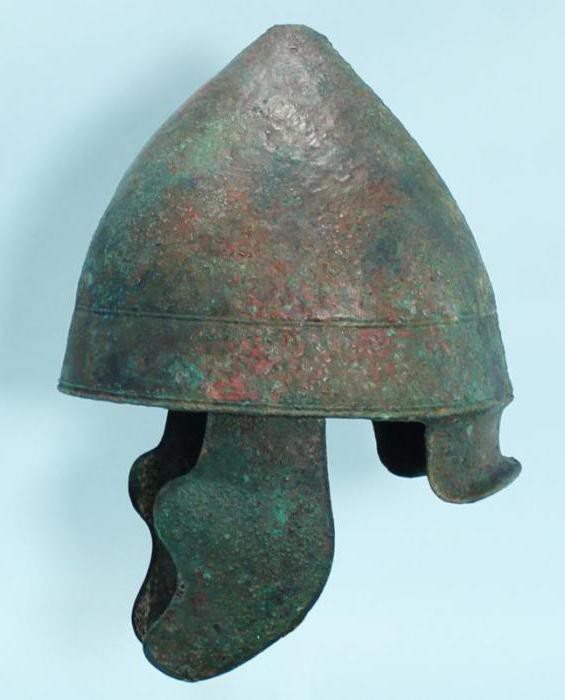

Over time there appeared a helmet-pilos made of bronze, which completely repeated the shape of a felt hat, but based on some ancient Greek records we can conclude that this type did not quite cope with its protective function, because it was not very strong.
Spartan meaning.
Sparta was an ancient state with an incredibly strong and well-trained army. Virtually every man became an elite warrior by the age of 20. The legendary army was made up of the toughest men who had passed many tests.
Spartan children from birth were tested for their toughness: weak, crippled, without a perfectly built body toddlers without pity were thrown over the cliff, left at forks in the road. It was believed that defectiveness was an indisputable reason to deprive the little man of life, as he would not make a good warrior. The result of such measures was the formation of a state with the strongest army and great weight on the world political scene.
The upbringing of the Spartan began at the age of seven, when the boy was taken from his family and placed with other pupils in a military camp. The young pupils' daily life was very harsh, they were fed with horrible stew, forced to exercise to the point of exhaustion, and to sleep on the ground. Great importance was paid to the psychological preparation of future soldiers - they were taught not to be afraid of death, cold, hunger and hard work.
Boys aged 14-15 were mercilessly whipped as a test. This ritual execution was held in honor of the goddess Diana and identified the most resilient young men - the teenagers who survived it became the elite of the army in the future. Units of heavily-armed fighters from Sparta were the most desirable of all the mercenaries providing their services in guarding the royalty of nearby states.
The Spartans did not recognize flowery speeches, preferring to communicate in short, clear phrases. The warriors despised any display of luxury, disapproving of expensive clothes or fine food, or comfort in their surroundings. The singers and musicians were scorned and the Spartans themselves sang only during great celebrations, with texts mentioning only how many enemies had been defeated and how many more would be killed. Even in the heyday of the state there was no place for poets, artists or actors. Only the practice of sports was encouraged.
It was compulsory for Spartans to marry, and the more healthy children the couple had, the more benefits the head of the family received. A woman was considered necessary only for the continuation of the family. Bachelors were humiliated and disgraced in public.
Styles and colors
The Spartan helmet is a tattoo that can be depicted using a variety of styles. The choice depends on personal preferences. Who likes the classics, choose black and white drawings. Lovers of everything bright - realism in color.
Engraving
Given that the Spartan helmet is part of the ancient world, you can use an engraving style. On the skin, the drawing will look like an engraving.
For such tattoos, the characteristic features are:
- Clear contours.
- Black and white scale.
- Neat lines.
- Shading.
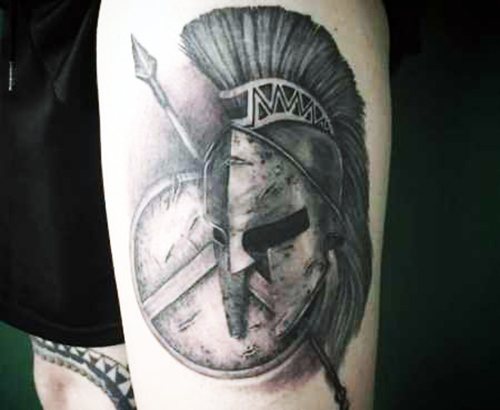

This style is suitable for drawings of not only the Spartan helmet, but also the hero wearing it. It is possible to play around with this headdress in different ways. Add some kind of battle, which will be the background of the main image - the helmet.
Realism .
Most often in this style do tattoos with sketches from movies about Sparta. This is a great way to convey the beauty of the time, with its military clothing and courageous, fearless faces. The main characters from the movies can be taken as the basis. The Spartan helmet is not necessarily drawn on the body in a solo version. There are plenty of sketches, in which it is supplemented with a warrior's face, or around to create a storyline with combat action.
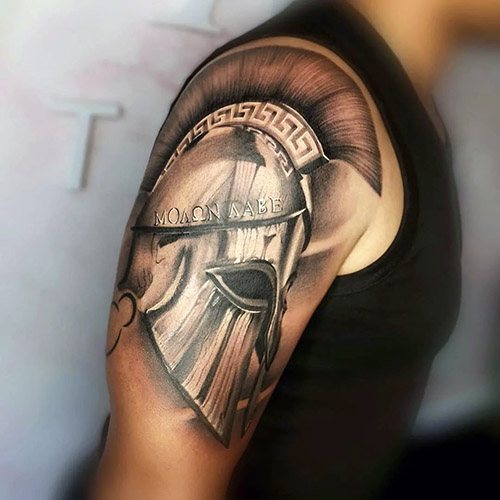

Realism welcomes bright colors. For a tattoo with a Spartan helmet must be present red and gold. Thanks to this, the drawing will look beautiful and realistic. It is worth bearing in mind that colored images will have to be regularly corrected, so that they do not lose their attractive appearance.
Black and white
Classic tattoos will not go out of fashion for a long time (according to critics). Black and white remains popular for decades. A Spartan helmet wristpiece in this style will look beautiful in one case: if the master can use all the shades of black.
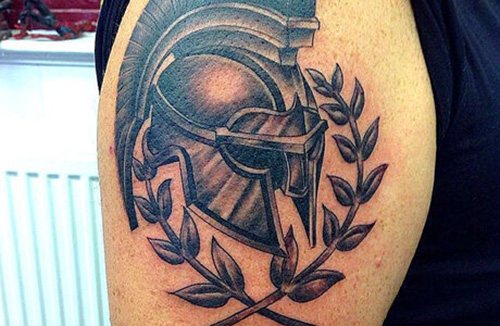

A professional of this craft knows how to convey all the facets and features of the drawing, using only the transitions between shades. Therefore, the appearance of the tattoo in the black palette can look no worse than in the color palette. The advantages of this direction is the durability of the tattoo. Dark pigments retain their durability for a long time. Also, the tattoo in this style will not lose relevance even after 10-20 years.
What style to get tattooed in
Often, the image is applied in red - brown tones, although and black - white works look beautiful enough. The best style for this tattoo - realism. Therefore, it is necessary to carefully approach the choice of the master, to address to the real professional of his business.
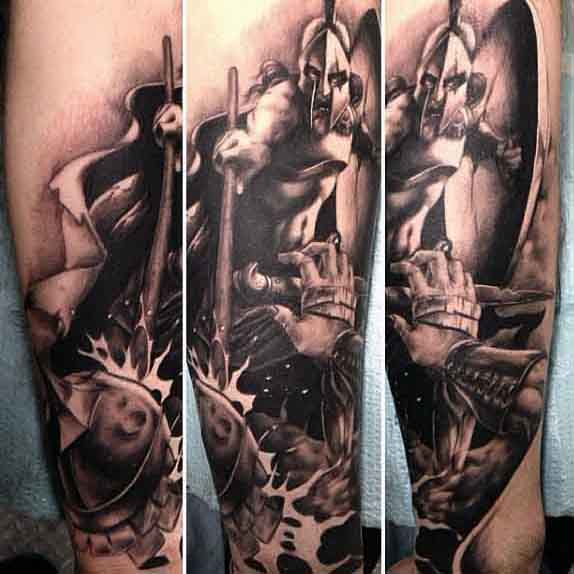

The Spartan helmet is rarely depicted directly without a warrior. Such works look spectacular "in dynamics", as if the fighter is on the move and ready to strike his enemy.
Among lovers of the culture of Ancient Sparta, images of the emblem of the state are common. Often, such works are supplemented with inscriptions, or Corinthian helmet, but in this case it is most often depicted in a graphic style.
Optimal place of application
This image will look best on the body of a brutal man. Girls this picture as a tattoo is unlikely to approach.


Based on the shape and volume of this subject, it is logical to apply the image on the oblong parts of the body:
- Arm (shoulder, forearm)
- Shin, calf
- Thigh
- Ribs
- Depending on the size, it is possible to draw on the back
5 / 5 ( 2 vote )

